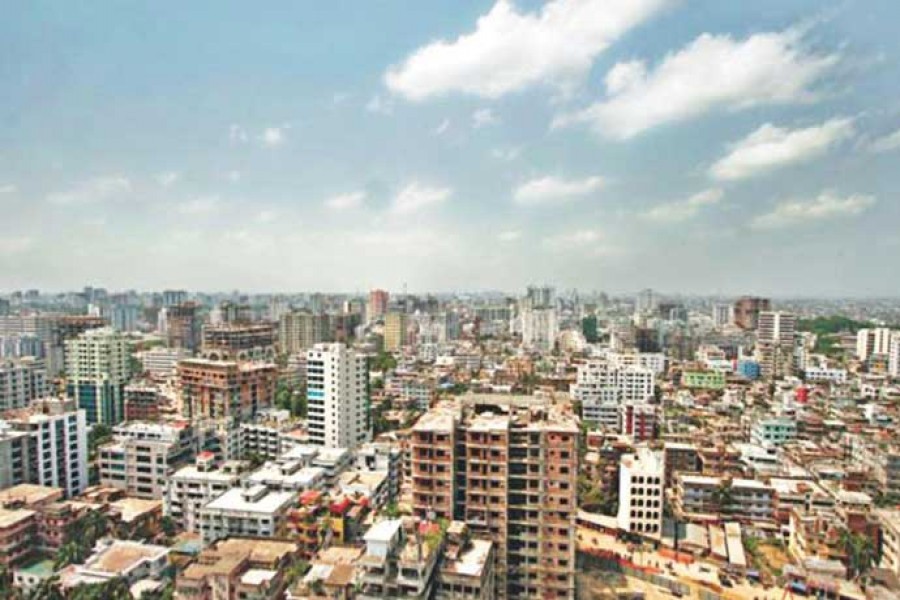Unplanned urbanisation is likely to pose a challenge to the nation's goal of becoming a developed country by 2041, according to analysts.
Marking the launch of a book titled 'Institutions for Development: Urbanisation and Land Issues in Bangladesh' in the city, they say the consequences of urbanisation in the current pattern on a piecemeal basis, heavily centred in the capital and without any strategic vision are not encouraging signs. This is also evident in the poor living condition of the city dwellers.
Indeed, urbanisation in the country has proceeded haphazardly with no strategic vision. There is little control over the conversion of land from agricultural to non-agricultural while land rights are highly insecure. There were little efforts for decentralisation of administration and establishment of an accountable city governance system.
In order to attain the desired goal, reforming institutions and securing people's land rights are crucial in the process of urbanisation for Bangladesh to become a developed country by 2041. It is assumed that half of the country's population will live in urban areas by 2030, leading to a further clumsy situation. As such, there is a need for planned development onwards.
Even after so many years of its formulation, recommendations of the Detailed Area Plan (DAP) of Dhaka could not be implemented, while population of this city is increasing consistently at 4.0 to 5.0 per cent rate annually. In the absence of a much-needed coordination, different government bodies are working haphazardly.
Huge onrush of population to Dhaka city needs to be tackled by ensuring basic civic services and creating employment opportunities in rural areas. Decentralisation of governance and development must be based on reforms and financial autonomy of the local government institutions.
In recent years, Bangladesh has experienced an annual urbanisation growth of 3.3 per cent with 55 million people living in the urban centres and the number is predicted to double in the next three decades or so. In order to become a mid-level income and high income country, institutional reforms as goals and targets require to be matched with strategies, policies and institutions. Most of the cities have high proportion of population living in very poor and overcrowded conditions in informal settlements. The residents there lack adequate water, sanitation, drainage, healthcare, sewerage etc.
Weak governance, whether in formal land administration or customary tenure arrangements, shows that land rights of the poor are not protected. In Dhaka city alone, about 9000 people live in per square kilometre -- about 30,000 in the city and 50,000 in its suburb. Everyday 1700 people are migrating to the city from rural areas for living.
After so many commitments from the authorities, only 26 canals could be reclaimed from the land grabbers after strenuous efforts. The rest of the canals are blocked with garbage. There is no effort at least to clean the drains.
Planned urbanisation is, in fact, structurally related with planned industrialisation. Weak institutional governance has been creating scope for rent seeking. Over the years, less attention was given to improve institutional capacities. At the global level there is now a growing need that institutions will function properly which is critical to development.
However, the importance of institutions for the development of Bangladesh is slowly becoming evident as economic transformation from a rural-agrarian base economy to a modern urban-centric manufacturing and services-based economy is happening. A study shows that while Bangladesh is making good progress on development strategy and policy front, the progress on institutions is weak. The country must put more emphasis on developing its core institutions to secure the long-term development targets.
According to a study conducted in 2016, a mere 12 per cent of the national population has access to piped water and only 20 per cent of the Dhaka population has access to a sewerage system that is connected to sewerage treatment plant. No other city has a treated sewerage system.
Analysts say politically-formed municipal areas are unnecessary, where citizens are deprived of services. Unplanned urbanisation there is also destroying the agricultural land. Many commercial buildings in the cities do not have approval, though planners sometimes develop good plans. Most of the areas of the municipalities look like rural areas. Many environment-polluting factories and industries are also being set up there. Rules are not followed in building construction which means people there are voicing concern over the lack of both law enforcement and public awareness.
On the other hand, Dhaka Water and Sewerage Authority (WASA) admits that their drainage system is inadequate. They are using pumps to drain out rain water. But it is only natural that the people will suffer if a city does not have a system of natural drainage. Drains need to be increased in number. The drains have to be cleared regularly and not just in the rainy season only.
An accurate, long-term and sustainable plan is needed to tackle the problem of water-logging. If urbanisation continues in this unplanned manner, then Dhaka, Chattagram and the other cities will be unfit for living.
As such, when it comes to construction, focus must be given on drainage. For this, expansion of infrastructure and regular maintenance are needed. The forcefully occupied canals, streams and other natural water bodies must be restored. Lack of proper policies or wrong policies or a combination of both was holding back the desired urbanisation in Bangladesh.
Bangladesh needs to address the critical challenges brought about by the massive unplanned urbanisation, characterised by high-level poverty and generally poor housing conditions and liveability. More than one out of five urban dwellers in Bangladesh lives in poverty.
In order to find out long-term solutions to such problems, the country can seek to influence the urbanisation path by diversifying growth-related activities along urban centres instead of continued concentration on a few large cities. Spreading the growth of cities will reduce the pressure on Dhaka and make its future growth more manageable.


